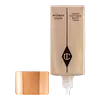What's inside
What's inside
 Key Ingredients
Key Ingredients

 Benefits
Benefits

 Concerns
Concerns

 Ingredients Side-by-side
Ingredients Side-by-side

Zinc Oxide 15%
Cosmetic ColorantWater
Skin ConditioningCoco-Caprylate/Caprate
EmollientVitis Vinifera Seed Oil
EmollientC15-19 Alkane
SolventIsocetyl Stearoyl Stearate
EmollientArgania Spinosa Kernel Oil
EmollientTocopheryl Acetate
AntioxidantSodium Hyaluronate Crosspolymer
HumectantJojoba Esters
EmollientTribehenin
EmollientBeeswax
Emulsion StabilisingGlyceryl Stearate
EmollientLeuconostoc/Radish Root Ferment Filtrate
AntimicrobialGlycerin
HumectantLactobacillus
Skin ConditioningAcacia Senegal Gum
MaskingXanthan Gum
EmulsifyingViola Tricolor Extract
EmollientBisabolol
MaskingGlycyrrhiza Glabra Root Extract
BleachingSodium Hyaluronate
HumectantAloe Barbadensis Leaf
MaskingCocos Nucifera Fruit Extract
EmollientTitanium Dioxide
Cosmetic ColorantIron Oxides
Mica
Cosmetic ColorantZinc Oxide 15%, Water, Coco-Caprylate/Caprate, Vitis Vinifera Seed Oil, C15-19 Alkane, Isocetyl Stearoyl Stearate, Argania Spinosa Kernel Oil, Tocopheryl Acetate, Sodium Hyaluronate Crosspolymer, Jojoba Esters, Tribehenin, Beeswax, Glyceryl Stearate, Leuconostoc/Radish Root Ferment Filtrate, Glycerin, Lactobacillus, Acacia Senegal Gum, Xanthan Gum, Viola Tricolor Extract, Bisabolol, Glycyrrhiza Glabra Root Extract, Sodium Hyaluronate, Aloe Barbadensis Leaf, Cocos Nucifera Fruit Extract, Titanium Dioxide, Iron Oxides, Mica
Water
Skin ConditioningDimethicone
EmollientCyclopentasiloxane
EmollientPolysilicone-11
Butylene Glycol
HumectantGlycerin
HumectantSilica
AbrasiveMica
Cosmetic ColorantSqualane
EmollientCI 77891
Cosmetic ColorantNylon-12
Isononyl Isononanoate
EmollientPhenoxyethanol
PreservativeHydroxyethyl Acrylate/Sodium Acryloyldimethyl Taurate Copolymer
Emulsion StabilisingSodium Potassium Aluminum Silicate
Avena Sativa Kernel Extract
AbrasiveEthylhexylglycerin
Skin ConditioningIsohexadecane
EmollientPEG-10 Dimethicone
Skin ConditioningTocopheryl Acetate
AntioxidantCarbomer
Emulsion StabilisingPolysorbate 60
EmulsifyingPolysorbate 40
EmulsifyingHydrolyzed Viola Tricolor Extract
Skin ProtectingCaramel
Cosmetic ColorantAllantoin
Skin ConditioningAloe Barbadensis Leaf Juice
Skin ConditioningDisodium EDTA
Camellia Oleifera Seed Oil
Skin ConditioningRosa Canina Fruit Oil
EmollientAmmonium Polyacryloyldimethyl Taurate
Emulsion StabilisingNylon-12 Fluorescent Brightener 230 Salt
Sodium Hydroxide
BufferingCI 77491
Cosmetic ColorantSodium Hyaluronate
HumectantSodium Lactate
BufferingSorbitan Isostearate
EmulsifyingCoco-Glucoside
CleansingCI 77492
Cosmetic ColorantParfum
MaskingCI 77499
Cosmetic ColorantPolyvinylalcohol Crosspolymer
Helianthus Annuus Seed Oil
EmollientPalmitoyl Tetrapeptide-7
Skin ConditioningPalmitoyl Tripeptide-1
Skin ConditioningTin Oxide
AbrasiveNicotiana Sylvestris Leaf Cell Culture
Skin ConditioningRosa Damascena Flower Oil
MaskingTocopherol
AntioxidantPlumeria Rubra Flower Extract
Skin ConditioningAnthemis Nobilis Flower Oil
MaskingCitronellol
PerfumingGeraniol
PerfumingWater, Dimethicone, Cyclopentasiloxane, Polysilicone-11, Butylene Glycol, Glycerin, Silica, Mica, Squalane, CI 77891, Nylon-12, Isononyl Isononanoate, Phenoxyethanol, Hydroxyethyl Acrylate/Sodium Acryloyldimethyl Taurate Copolymer, Sodium Potassium Aluminum Silicate, Avena Sativa Kernel Extract, Ethylhexylglycerin, Isohexadecane, PEG-10 Dimethicone, Tocopheryl Acetate, Carbomer, Polysorbate 60, Polysorbate 40, Hydrolyzed Viola Tricolor Extract, Caramel, Allantoin, Aloe Barbadensis Leaf Juice, Disodium EDTA, Camellia Oleifera Seed Oil, Rosa Canina Fruit Oil, Ammonium Polyacryloyldimethyl Taurate, Nylon-12 Fluorescent Brightener 230 Salt, Sodium Hydroxide, CI 77491, Sodium Hyaluronate, Sodium Lactate, Sorbitan Isostearate, Coco-Glucoside, CI 77492, Parfum, CI 77499, Polyvinylalcohol Crosspolymer, Helianthus Annuus Seed Oil, Palmitoyl Tetrapeptide-7, Palmitoyl Tripeptide-1, Tin Oxide, Nicotiana Sylvestris Leaf Cell Culture, Rosa Damascena Flower Oil, Tocopherol, Plumeria Rubra Flower Extract, Anthemis Nobilis Flower Oil, Citronellol, Geraniol
Alternatives
Ingredients Explained
These ingredients are found in both products.
Ingredients higher up in an ingredient list are typically present in a larger amount.
Glycerin is already naturally found in your skin. It helps moisturize and protect your skin.
A study from 2016 found glycerin to be more effective as a humectant than AHAs and hyaluronic acid.
As a humectant, it helps the skin stay hydrated by pulling moisture to your skin. The low molecular weight of glycerin allows it to pull moisture into the deeper layers of your skin.
Hydrated skin improves your skin barrier; Your skin barrier helps protect against irritants and bacteria.
Glycerin has also been found to have antimicrobial and antiviral properties. Due to these properties, glycerin is often used in wound and burn treatments.
In cosmetics, glycerin is usually derived from plants such as soybean or palm. However, it can also be sourced from animals, such as tallow or animal fat.
This ingredient is organic, colorless, odorless, and non-toxic.
Glycerin is the name for this ingredient in American English. British English uses Glycerol/Glycerine.
Learn more about GlycerinMica is a naturally occurring mineral used to add shimmer and color in cosmetics. It can also help improve the texture of a product or give it an opaque, white/silver color.
Serecite is the name for very fine but ragged grains of mica.
This ingredient is often coated with metal oxides like titanium dioxide. Trace amounts of heavy metals may be found in mica, but these metals are not harmful in our personal products.
Mica has been used since prehistoric times throughout the world. Ancient Egyptian, Indian, Greek, Roman, Aztec, and Chinese civilizations have used mica.
Learn more about MicaSodium Hyaluronate is hyaluronic acid's salt form. It is commonly derived from the sodium salt of hyaluronic acid.
Like hyaluronic acid, it is great at holding water and acts as a humectant. This makes it a great skin hydrating ingredient.
Sodium Hyaluronate is naturally occurring in our bodies and is mostly found in eye fluid and joints.
These are some other common types of Hyaluronic Acid:
Learn more about Sodium HyaluronateTocopheryl Acetate is AKA Vitamin E. It is an antioxidant and protects your skin from free radicals. Free radicals damage the skin by breaking down collagen.
One study found using Tocopheryl Acetate with Vitamin C decreased the number of sunburned cells.
Tocopheryl Acetate is commonly found in both skincare and dietary supplements.
Learn more about Tocopheryl AcetateWater. It's the most common cosmetic ingredient of all. You'll usually see it at the top of ingredient lists, meaning that it makes up the largest part of the product.
So why is it so popular? Water most often acts as a solvent - this means that it helps dissolve other ingredients into the formulation.
You'll also recognize water as that liquid we all need to stay alive. If you see this, drink a glass of water. Stay hydrated!
Learn more about Water